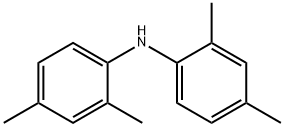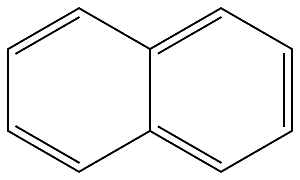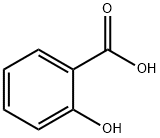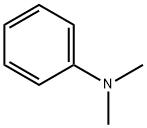Bis(2,4-dimethylphenyl)amine
- CAS NO.:19616-28-5
- Empirical Formula: C16H19N
- Molecular Weight: 225.33
- MDL number: MFCD16619146
- EINECS: 1533716-785-6
- SAFETY DATA SHEET (SDS)
- Update Date: 2024-06-12 17:09:18

What is Bis(2,4-dimethylphenyl)amine?
Chemical properties
White powder
The Uses of Bis(2,4-dimethylphenyl)amine
Bis(2,4-dimethylphenyl)amine is a pharmaceutical intermediate widely used in food, health care products, cosmetics and other fields.
Synthesis
2,4-dimethylaniline 2.67 g (molecular weight 121,22 mmol) was added to a 100 ml reaction flask under nitrogen.2.68 g of 2,4-dimethylbromobenzene (molecular weight 184,20 mmol), 5.76 g of sodium tert-butoxide (molecular weight 96,60 mmol), Pd2(dba)3 183 mg (molecular weight 916, 0.2 mmol), P(tBu)3 121 mg (molecular weight 202, 0.6 mmol).Anhydrous toluene 50 ml.After the addition, the oil bath was slowly heated to reflux reaction, and TLC monitored the reaction end, and the reaction was completed in 10 hours. Cooled, quenched with water, and extracted with 50ml of dichloromethane, the organic phase dried over anhydrous MgSO4, and the organic phase evaporated to dryness; the resulting solid was separated by column chromatography to give a white solid Bis(2,4-dimethylphenyl)amine 3.8g, molecular weight 225, 85percent yield.
Properties of Bis(2,4-dimethylphenyl)amine
| Melting point: | 57.0 to 61.0 °C |
| Boiling point: | 310°C(lit.) |
| Density | 1.021 |
| storage temp. | Keep in dark place,Sealed in dry,Room Temperature |
| solubility | soluble in Methanol |
| form | powder to crystal |
| pka | 1.43±0.50(Predicted) |
| color | White to Orange to Green |
| InChI | InChI=1S/C16H19N/c1-11-5-7-15(13(3)9-11)17-16-8-6-12(2)10-14(16)4/h5-10,17H,1-4H3 |
| CAS DataBase Reference | 19616-28-5 |
Safety information for Bis(2,4-dimethylphenyl)amine
| Signal word | Warning |
| Pictogram(s) |
 Exclamation Mark Irritant GHS07 |
| GHS Hazard Statements |
H315:Skin corrosion/irritation H319:Serious eye damage/eye irritation |
| Precautionary Statement Codes |
P280:Wear protective gloves/protective clothing/eye protection/face protection. P302+P352:IF ON SKIN: wash with plenty of soap and water. P305+P351+P338:IF IN EYES: Rinse cautiously with water for several minutes. Remove contact lenses, if present and easy to do. Continuerinsing. P332+P313:IF SKIN irritation occurs: Get medical advice/attention. P337+P313:IF eye irritation persists: Get medical advice/attention. |
Computed Descriptors for Bis(2,4-dimethylphenyl)amine
| InChIKey | MAINCNYZMOMWRA-UHFFFAOYSA-N |
| SMILES | C1(NC2=CC=C(C)C=C2C)=CC=C(C)C=C1C |
New Products
4-AMINO-TETRAHYDRO-PYRAN-4-CARBOXYLIC ACID HCL 4-(Dimethylamino)tetrahydro-2H-pyran-4-carbonitrile 4-Aminotetrahydropyran-4-carbonitrile Hydrochloride (R)-3-Aminobutanenitrile Hydrochloride 3-((Dimethylamino)methyl)-5-methylhexan-2-one oxalate 1,4-Dioxa-8-azaspiro[4.5]decane 5-Bromo-2-nitropyridine Nimesulide BP Aceclofenac IP/BP/EP Diclofenac Sodium IP/BP/EP/USP Mefenamic Acid IP/BP/EP/USP Ornidazole IP Diclofenac Potassium THOMAIND PAPER PH 2.0 TO 4.5 1 BOX BUFFER CAPSULE PH 9.2 - 10 CAP SODIUM CHLORIDE 0.1N CVS ALLOXAN MONOHYDRATE 98% PLATINUM 0.5% ON 3 MM ALUMINA PELLETS (TYPE 73) LITHIUM AAS SOLUTION 2-Bromo-1-(bromomethyl)-3-chloro-5-nitrobenzene 2-Bromo-3-nitroaniline N-(3-Hydroxypropyl)-N-methylacetamide 3-Bromo-6-chloropyridazine 4-ethyl-3-nitrobenzoic acidRelated products of tetrahydrofuran
You may like
-
 N-(2,4-Dimethylphenyl)-2,4-dimethylbenzenamine 95% CAS 19616-28-5View Details
N-(2,4-Dimethylphenyl)-2,4-dimethylbenzenamine 95% CAS 19616-28-5View Details
19616-28-5 -
 Bis(2,4-dimethylphenyl)amine CAS 19616-28-5View Details
Bis(2,4-dimethylphenyl)amine CAS 19616-28-5View Details
19616-28-5 -
 Bis(2,4-dimethylphenyl)amine 98% (HPLC) CAS 19616-28-5View Details
Bis(2,4-dimethylphenyl)amine 98% (HPLC) CAS 19616-28-5View Details
19616-28-5 -
 1823368-42-8 98%View Details
1823368-42-8 98%View Details
1823368-42-8 -
 2-(3-(tert-butyl)phenoxy)-2-methylpropanoic acid 1307449-08-6 98%View Details
2-(3-(tert-butyl)phenoxy)-2-methylpropanoic acid 1307449-08-6 98%View Details
1307449-08-6 -
 Ethyl 3-(furan-2-yl)-3-hydroxypropanoate 25408-95-1 98%View Details
Ethyl 3-(furan-2-yl)-3-hydroxypropanoate 25408-95-1 98%View Details
25408-95-1 -
 2-Chloro-5-fluoro-1-methoxy-3-methylbenzene 98%View Details
2-Chloro-5-fluoro-1-methoxy-3-methylbenzene 98%View Details
1805639-70-6 -
 Lithium ClavulanateView Details
Lithium ClavulanateView Details
61177-44-4


